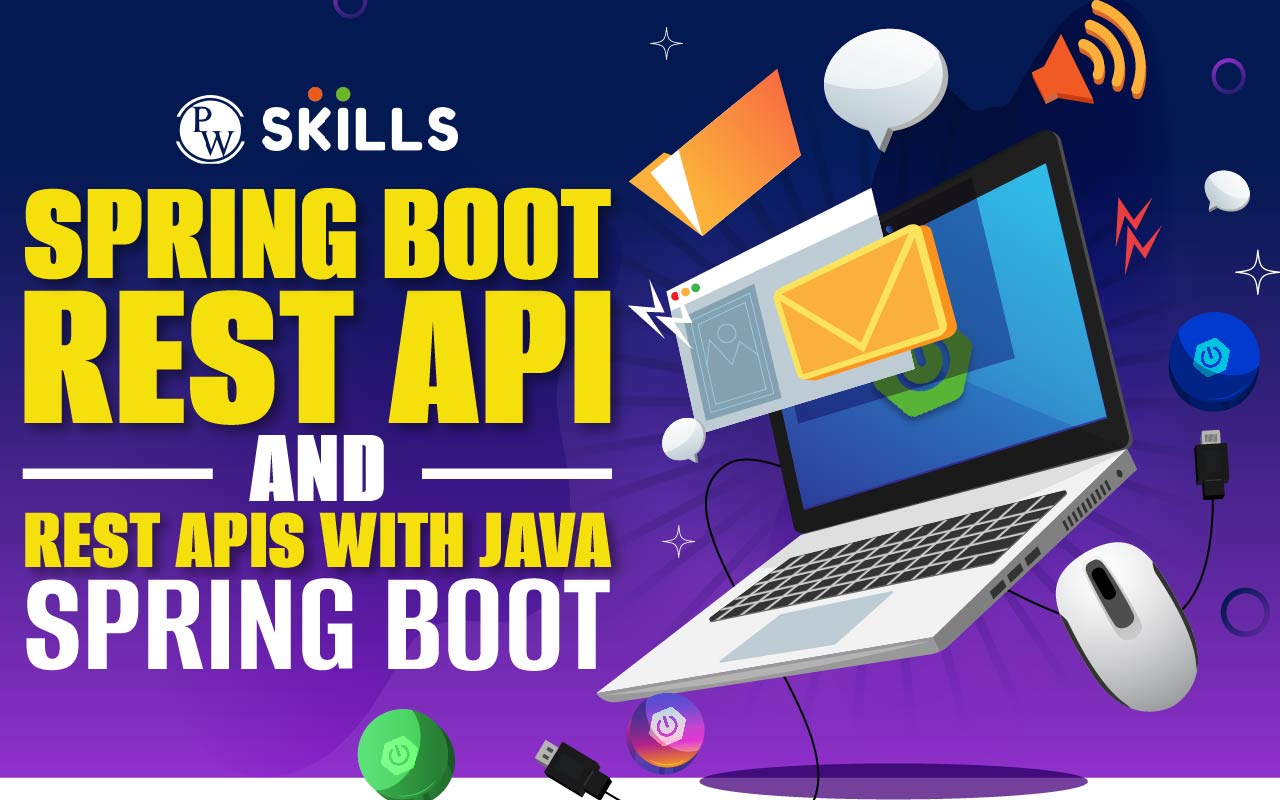Spring Boot REST API: Spring Boot is a famous JAVA framework. Plus, learning to make REST APIs in Spring Boot is highly beneficial! So, learn everything you need to know to build high-performing APIs.
Spring Boot Rest API: In the realm of Java development, building robust and efficient RESTful APIs is a skill that can elevate your projects to new heights. Spring Boot, a popular framework in the Java ecosystem, simplifies the process of creating RESTful services, allowing developers to focus on business logic rather than infrastructure. In this blog, we’ll talk about Spring Boot Rest API Tutorial, best practices, examples, exception handling, and much more!
Spring Boot Rest API Tutorial
Spring Boot is an extension of the Spring framework that simplifies the process of building production-ready applications with minimal configuration.
Here’s a step-by-step guide for creating a basic Spring Boot Rest API:
Step 1: Set Up the Development Environment
Before starting any Spring Boot project, it’s essential to have the right tools installed:
Java Development Kit (JDK)
Ensure that you have the appropriate version of the JDK installed. You can download it from the official Oracle website or use OpenJDK.
Integrated Development Environment (IDE)
Choose an IDE that supports Java development. IntelliJ IDEA and Eclipse are popular choices. IntelliJ IDEA, in particular, has good support for Spring Boot projects and provides a seamless development experience.
Maven (Optional)
While Maven is optional, it’s a widely used build tool for managing dependencies in Java projects. You can download and install Maven from the official Apache Maven website.
Step 2: Create a Spring Boot Project
Now, let’s create a new Spring Boot project:
- Open your IDE and choose to create a new project.
- Select the Spring Initializer or Spring Boot option, and then configure your project details, such as Group, Artefact, and Package names.
- Choose the appropriate Spring Boot version.
- Add dependencies: Include the “Spring Web” dependency, which includes everything you need to build a basic web application.
Once your project is created, your directory structure should contain the main application class annotated with @SpringBootApplication.
Step 3: Define a Model Class
In a Spring Boot Rest API, a model class represents the data entities you want to work with. For example, let’s consider a Book class:
In this example, the @Entity annotation indicates that this class is a JPA entity, and @Id specifies the primary key. The @GeneratedValue annotation ensures that the ID is automatically generated.
Step 4: Create a Controller
A controller in Spring Boot handles incoming HTTP requests and provides appropriate responses. Create a BookController class:
In this controller, each method corresponds to a different HTTP endpoint, specifying the HTTP method (@GetMapping, @PostMapping, etc.) and the URL mapping.
Step 5: Implement Service Layer
A service layer contains the business logic of your application. Create a BookService interface and its implementation:
The service interface defines the contract for the operations, and the implementation (BookServiceImpl) provides the actual implementation using a repository (more on this in the next step).
Step 6: Configure Database (Optional)
If you want to persist data, you can configure a database using Spring Data JPA. Ensure you have the necessary database dependencies in your pom.xml (if you’re using Maven):
Configure your application.properties or application.yml file to set up your database connection:
Replace your_database, your_username, and your_password with your actual database details.
Step 7: Run and Test
Now, you can run your Spring Boot application. The embedded Tomcat server will start, and your application will be accessible at http://localhost:8080.
Test your REST API using tools like Postman or cURL. Here are some sample requests:
- GET All Books: GET http://localhost:8080/api/books
- GET Book by ID: GET http://localhost:8080/api/books/{id}
- POST Add Book: POST http://localhost:8080/api/books with JSON payload
- PUT Update Book: PUT http://localhost:8080/api/books/{id} with JSON payload
- DELETE Book: DELETE http://localhost:8080/api/books/{id}
Also read: Java Tutorial For Complete Beginners
Spring Boot Rest API Best Practices
Developing Rest APIs with Spring Boot is more than just writing functional code; it involves adhering to best practices that ensure scalability, maintainability, and overall robustness. Let’s delve into key best practices for Spring Boot Rest API development:
Structuring Your Spring Boot Rest API Project
Organising your project effectively is essential for long-term maintainability. Adopt the package-by-feature approach, where packages reflect the features or components of your application. This helps in creating a modular and easily navigable codebase. Consider grouping related classes, such as controllers, services, and models, within their respective packages.
Handling Versioning in Restful Services
Versioning is crucial in maintaining compatibility as your Rest API evolves. Different versioning strategies exist, such as URI versioning, request header versioning, and content negotiation. Choose an approach that aligns with your project’s requirements. Keep in mind that clear communication with API consumers about version changes is crucial to avoid disruptions.
Security Best Practices for Restful APIs
Securing your Rest API is non-negotiable. Leverage Spring Security to implement authentication and authorization mechanisms. Utilise features like JSON Web Tokens (JWT) for stateless authentication. Follow the principle of least privilege, granting only the necessary permissions to users or roles. Regularly update dependencies and stay informed about security best practices.
Optimising Performance in Spring Boot Rest API
Performance optimization is key for delivering a responsive and efficient Rest API. Implement caching mechanisms strategically to reduce redundant data retrieval operations. Explore request/response compression to minimise data transfer size.
Consider leveraging asynchronous processing, especially for I/O-bound operations, to improve overall system responsiveness. Monitor your Rest API’s performance using tools like Spring Boot Actuator.
Recommended Technical Course
- Full Stack Web Development Course
- Generative AI Course
- DSA C++ Course
- Java+DSA 1.0 Course
- Data Analytics Course
- Data Science with ML 1.0 Course
Spring Boot Rest API Interview Questions
Preparing for a Spring Boot Rest API interview requires a deep understanding of fundamental concepts and practical application. Here’s an overview of common interview questions to help you prepare effectively:
- What is Spring Boot, and how does it differ from the traditional Spring framework?
Understand the purpose of Spring Boot and its convention-over-configuration approach for rapid development. Differentiate it from the traditional Spring framework.
- Explain the key components of a Spring Boot application.
Discuss essential components like @SpringBootApplication, the main application class, and the application.properties (or application.yml) file.
- What is the role of the @RestController annotation in Spring Boot?
Describe how @RestController is used to define Restful controllers and handle HTTP requests. Differentiate it from the traditional @Controller annotation.
- How does Spring Boot handle dependency injection, and why is it important?
Explain the concept of inversion of control (IoC) and how Spring Boot achieves dependency injection. Discuss the benefits of loose coupling and testability.
Questions from Key Concepts
- Explain the significance of the @RequestMapping annotation.
Elaborate on how @RequestMapping is used to map HTTP requests to specific methods and URIs in a Spring Boot Rest API.
- What are the primary HTTP methods used in Restful services, and how does Spring Boot support them?
Discuss common HTTP methods (GET, POST, PUT, DELETE) and explain how Spring Boot simplifies their implementation using annotations like @GetMapping and @PostMapping.
- How does Spring Boot handle exception handling in Restful services?
Discuss the importance of effective exception handling in Restful services and how Spring Boot provides mechanisms like @ControllerAdvice for global exception handling.
- Explain the concept of content negotiation in Spring Boot Rest API.
Discuss how content negotiation allows clients to request specific response formats (e.g., JSON, XML) and how Spring Boot supports it.
Also read: Core Java Syllabus and Advanced Java Concepts
Technical Questions
- How does Spring Boot support data validation in Rest API input?
Discuss the use of validation annotations and custom validation logic to ensure the integrity of data received in Rest API requests.
- What is Spring Boot Actuator, and how can it be useful in Rest API development?
Explain the role of Spring Boot Actuator in monitoring and managing Spring Boot applications. Discuss its endpoints for health checks, metrics, and more.
- How does Spring Boot handle security in Restful services?
Discuss the integration of Spring Security for authentication and authorization in a Spring Boot Rest API. Explain common security mechanisms like JWT (JSON Web Tokens).
Spring Boot Rest API Example
Now that we’ve covered the fundamentals of Spring Boot Rest API development, let’s embark on a practical journey by building a fully functional Rest API. This example will guide you through the process of creating a basic Rest API project, implementing CRUD (Create, Read, Update, Delete) operations, and integrating database operations using Spring Boot.
Building a Practical Rest API Project
Project Setup
- Initialise a Spring Boot Project: Use Spring Initializer or your preferred IDE to set up a new Spring Boot project. Select the necessary dependencies, including Spring Web to enable Rest API development.
- Project Structure: Adopt a clean project structure. Organise your code using the package-by-feature approach, separating concerns such as controllers, services, repositories, and models.
Demonstrating CRUD Operations
- Create Entity Class: Define a simple entity class representing the resource you want to manage in your Rest API. An entity might represent a ‘Product,’ ‘User,’ or any other domain object.
- Implement Repository: Create a repository interface using Spring Data JPA to handle database operations. This interface will extend the JpaRepository and provide methods for CRUD operations.
- Service Layer: Implement a service layer that acts as an intermediary between the controllers and repositories. Business logic, validation, and transaction management can be handled in this layer.
- RESTful Controllers: Develop controllers using the @RestController annotation. Define endpoints for creating, retrieving, updating, and deleting resources. Leverage appropriate HTTP methods like POST, GET, PUT, and DELETE.
Also read: Multithreading in Java
Integrating Database Operations with Spring Boot
- Entity-Repository-Service Integration: Wire up the entity, repository, and service layers. Use dependency injection to inject the service into the controller and the repository into the service.
- Data Validation: Implement data validation mechanisms in your service layer. Leverage validation annotations such as @NotBlank, @NotNull, or custom validations based on your requirements.
- Exception Handling: Implement global exception handling using @ControllerAdvice to ensure consistent error responses. Customise exception classes to handle specific scenarios gracefully.
Testing and Debugging the Rest API
- Unit Testing: Write unit tests for your service and repository methods using testing frameworks like JUnit and Mockito. Ensure that your business logic is correctly implemented, and database interactions behave as expected.
- Integration Testing: Perform integration tests for your Rest API endpoints. Use tools like SpringBootTest to test the entire application context, including the controllers and their interactions with the database.
- End-to-End Testing: Conduct end-to-end tests to verify the functionality of your Rest API as a whole. Test scenarios that involve making actual HTTP requests to your API and verifying the responses.
Conclusion
As we conclude this blog, let’s recap the key learnings. From setting up your Spring Boot project to mastering Rest API best practices, exception handling, and CRUD operations, you’ve gained a solid understanding of building robust Rest APIs with Java and Spring Boot.
The world of Spring Boot Rest API development is vast and ever-evolving. So, continue exploring advanced topics such as microservices architecture, API documentation with Swagger, and integration with other technologies like Docker and Kubernetes.
If you want to become a java developer, then the Java+DSA 1.0 Course is highly recommended! Our course is based on the latest industry standards and will definitely help you become a highly paid java developer! So, don’t wait! Use the coupon code – READER at checkout and avail an exclusive discount just for you!
Also read: 10 Most Common Java Tools Expert Java Developers Use in 2024
FAQs
What is the significance of using Spring Boot for Rest API development?
Spring Boot simplifies the process of building Rest APIs in Java by providing a convention-over-configuration approach. It offers a set of powerful annotations and features that streamline development, making it faster and more efficient.
How can I handle exceptions effectively in a Spring Boot Rest API?
Spring Boot offers robust mechanisms for exception handling. Utilise global exception handlers with @ControllerAdvice, create custom exception classes, and implement logging strategies. Monitoring exceptions with Spring Boot Actuator enhances visibility into your application's health.
Why is versioning important in Restful API development, and what are the recommended strategies?
Versioning ensures smooth transitions and backward compatibility in Restful services. Explore various versioning strategies, such as URI versioning, request header versioning, and content negotiation, to choose the one that best fits your project requirements.
What are the key security practices for securing a Spring Boot Rest API?
Securing a Spring Boot Rest API involves implementing authentication, authorization, and token-based access control. Explore Spring Security features, role-based access control, and token-based authentication to protect sensitive resources and ensure the security of your API.
How can I test and debug a Spring Boot Rest API effectively?
Testing is integral to the development process. Learn different testing strategies, including unit testing, integration testing, and end-to-end testing, using tools like JUnit and Mockito. Understand effective debugging techniques to identify and resolve issues in your Spring Boot Rest API.




